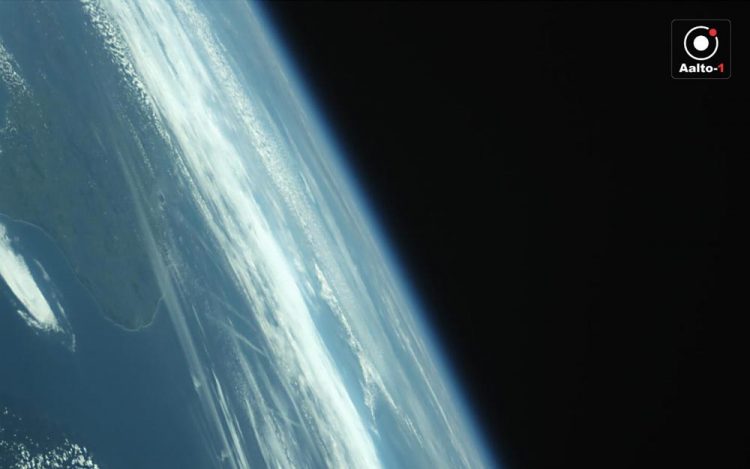Aalto-1 satellite sends first image — the camera developed by VTT

The image shows the Danish coast as well as a portion of the Norwegian coastline. Photo: Aalto University, VTT and Aalto-1 team
'We have run checks on the majority of the satellite's systems and found that the devices are fully functional,' Aalto University's Professor Jaan Praks, who is heading the satellite project, explains.
'We have also downloaded the first image sent by Aalto-1, which is also the first ever image taken from a Finnish satellite. It was taken while on orbit over Norway at an altitude of about 500 kilometres. The image shows the Danish coast as well as a portion of the Norwegian coastline.
The photograph was taken by the secondary camera for the VTT-developed hyperspectral camera. The secondary camera faces the same direction as the main hyperspectral camera, but it has a slightly broader view angle to support, the analysis of the hyperspectral camera's images.
'On the basis of this first image, the system works as planned. The main hyperspectral camera will be tested later this week,' Research Scientist Antti Näsilä from VTT says.
Unlike traditional cameras, which measure three colours, the hyperspectral camera is able to measure dozens of freely selected narrow color channels. For this reason, it can be utilised for example in surveying forest types, algae and vegetation and as a tool in geological research.
The Aalto-1 satellite is also carrying a radiation monitor jointly constructed by the Universities of Helsinki and Turku and a Plasma Brake built by the Finnish Meteorological Institute. When the time comes, the brake will allow the satellite to slow down and fall into the Earth's atmosphere where it will burn to dust, ensuring that it will not be left behind as space debris.
'The plasma brake has naturally not been tested yet. However, we have used the radiation monitor to measure an area of high radiation called the South Atlantic Anomaly,' Petri Niemelä Manager of the Otaniemi base station, which is overseeing the operations of the satellite, explains.
A year of measurements
Jaan Praks emphasises that although the functionality of the technology has been demonstrated, the satellite mission itself is only in its early stages. The plan is to collect data and images over the course of several months or even an entire year. The mission schedule also includes stabilising of the satellite's attitude.
'Until now, we have allowed the satellite to slowly tumble as this is ideal with regard to spacecraft temperature management. So far, the satellite's internal temperature has remained wonderfully between zero and 25 Celsius for the duration of its mission, alternating according to whether the the satellite has been in shade or light.'
From Aalto University's and Finland's perspectives space research prospects are bright. Nanosatellites developed by numerous start-ups as well as a third Aalto satellite, i.e. the Suomi 100, are to be launched into space this year.
'Finland now has the opportunity to register its first space device in the UN's international Register of Objects Launched into Outer Space,' Mr Praks notes.
###
Upload photo: http://www.
Further information:
VTT Technical Research Centre of Finland
Antti Näsilä, Research Scientist
Tel. +358 40 671 6266
antti.nasila@vtt.fi
Jaan Praks
Professor, project director
Aalto University
Tel. +358 50 420 5847
jaan.praks@aalto.fi
Antti Kestilä
Head of the Aalto-1 mission operations
Aalto University
Tel. +358 44 238 3164
antti.kestila@aalto.fi
Petri Niemelä Head of the Otaniemi ground-station station
Aalto University
Tel. +358 50 400 4246
petri.niemela@aalto.fi
Media Contact
All latest news from the category: Physics and Astronomy
This area deals with the fundamental laws and building blocks of nature and how they interact, the properties and the behavior of matter, and research into space and time and their structures.
innovations-report provides in-depth reports and articles on subjects such as astrophysics, laser technologies, nuclear, quantum, particle and solid-state physics, nanotechnologies, planetary research and findings (Mars, Venus) and developments related to the Hubble Telescope.
Newest articles

Properties of new materials for microchips
… can now be measured well. Reseachers of Delft University of Technology demonstrated measuring performance properties of ultrathin silicon membranes. Making ever smaller and more powerful chips requires new ultrathin…

Floating solar’s potential
… to support sustainable development by addressing climate, water, and energy goals holistically. A new study published this week in Nature Energy raises the potential for floating solar photovoltaics (FPV)…

Skyrmions move at record speeds
… a step towards the computing of the future. An international research team led by scientists from the CNRS1 has discovered that the magnetic nanobubbles2 known as skyrmions can be…





















